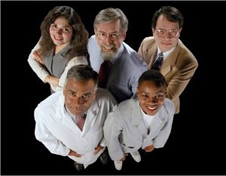September 29, 2009 Vol. 2, Issue 9
Recent efforts to build and retain the aerospace workforce have led to some progress, according to the 2009 Inside Aerospace Forum.
It’s no secret that the aerospace industry’s workforce is aging and the line to fill in these soon-to-be vacated slots is shorter than the industry would like. A year ago, the 2008 Inside Aerospace Forum identified the key drivers of the problem: insufficient volume of engineering graduates entering the industry, a lack of diversity in the field, and previous hire-and-layoff practices.

Diverse workforces like this one at Glenn Research Center are instrumental in growing the aerospace industry.
Last year’s forum recommended changes to the nation’s educational and social environment, the industry’s recruitment and retention of new employees, and fostering inspiration within the industry to regenerate and reenergize the aerospace workforce. This year’s forum reviewed the progress made on these recommendations over the past year.
The 2009 forum participants, consisting of members of industry, government, non-government organizations, and academia, presented their findings on the preparation and motivation of pre-career students and the need for professional development to retain the skilled workforce as outlined in the 2008 report. Current efforts that use social media like Facebook and Twitter to communicate, programs like Rocket Science Tutors, and efforts to introduce hands-on material earlier in college courses were all cited as positive actions by the forum participants. They found that interest in aerospace among the younger generation is still strong, but that outreach needs to be more effective. Recruiting dedicated mentors, developing programs that cater to student interests, restructuring science, technology, engineering, and math (STEM) programs, and increasing industry efforts to connect with students all need further enhancement.
The forum recommended that actions to retain the workforce involve cultivating a new mindset and culture. Leaders should emphasize that failure is important to learning, increase the use of teams to encourage high performance, and pass their leadership knowledge on to the next generation.
Enhancing inspiration within the industry can be addressed from several angles, according to the forum participants. Drawing on studies such as the National Academy of Engineering’s report “Changing the Conversation: Messages for Improving Understanding of Engineering,” forum participants looked at issues such as the poor public understanding of the engineering profession and the overall shortage of role models, particularly for women and minorities. While the engineering profession may not be winning over the interest of the general public, the report concluded that it is gaining recognition as a critical profession for large social programs such as energy, the environment, and health care. It also found that educational programs like Rocket Science Tutors are creating role models.
The forum concluded that continued efforts should focus on rebuilding the nation’s image of aerospace and how it contributes to society, engaging students in the K-12 grade levels and universities, and infusing the industry with more diversity. Efforts to recruit more women and minorities will bring in untapped sources of talent that will contribute to the industry. Programs like “The World in Motion,” created by the Society of Automotive Engineers to increase the number of African-Americans in the profession, set a positive example for achieving this goal. Efforts at the University of Southern California and the Missouri University of Science through the Boeing Systems Engineering Program serve as models for addressing the forum’s recommendation to introduce systems engineering training earlier in an engineer’s career.





